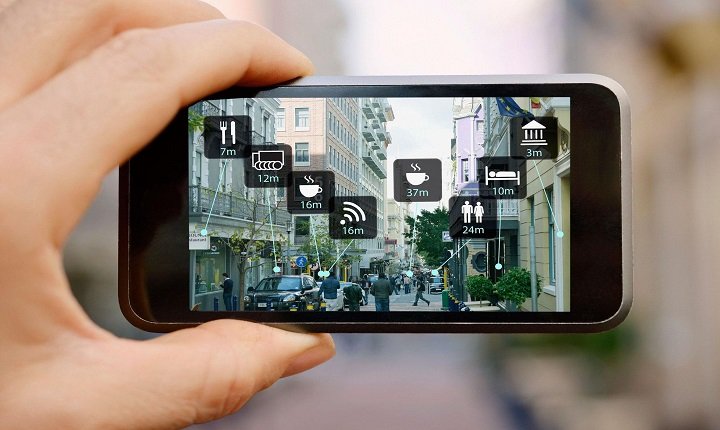AR and VR mobile applications development increased Reality (AR) and Virtual Reality (VR) have taken the computerized world by storm. From video recreations to instruction and commerce, AR and VR advances are changing how we connect with advanced substances. But what precisely are AR and VR? How are they created for portable gadgets, and why is this important?a
In this web journal, we will investigate AR and VR versatile application improvement. We’ll break down the essentials, the key advances included, and the preparation for making versatile apps that utilize AR and VR. We’ll too highlight the developing significance of these advances in different businesses and give answers to common questions related to this energizing field.
What is AR and VR mobilapplicationns development?

Before we jump into improvement, let’s begin with the basics.
Increased Reality (AR)
Increased reality (AR) occurs when a preset substance overlaps the real world. For example, in multipurpose apps like Pokémon GO, virtual fonts are shown on your screen as if they exist in the physical world around you. AR apps utilize your phone’s camera and sensors to put virtual objects in a true environment.
Virtual Reality (VR)
Virtual Reality (VR), on the other hand, is a fully immersive meet where you enter a preset world. VR requires rare headsets, like the Oculus Fracture or Google Cardboard, to transport you to a virtual setting. Instead of seeing advanced substances in the real world, you step into a computer-generated 3D world.
The Significance of AR and VR Mobile Applications Development
Both AR and VR are vital since they offer unused ways to connect with advanced substances. In the past, we connected with innovation primarily through screens. But AR and VR open the entryway to immersive encounters that make learning, playing, or working more engaging.
The Developing Request for AR and VR in Portable Apps
Why is there so much buzz around AR and VR in versatile application advancement? There are a few reasons why AR and VR are picking up footing, particularly for portable devices.
1. Accessibility
Mobile gadgets are all over. Agreeing to later ponders, there are over 6 billion smartphone clients around the world. With so numerous versatile clients, creating AR and VR apps for versatility is a keen way to reach an expansive audience.
2. Improved Client Experience
AR and VR offer an interesting way to lock in clients. For illustration, in the retail industry, AR apps permit clients to “attempt on” dress or see how furniture will look in their domestic time recently making a buy. This makes a more personalized shopping encounter that is incomprehensible with conventional apps.
3. Assorted Utilize Cases of AR and VR mobile applications development
AR and VR are being utilized in different businesses, from gaming and excitement to instruction, healthcare, and genuine domains. These innovations permit businesses to offer something special and intuitively, which can help them stand out from the competition.
4. Mechanical Advancements
Thanks to progressions in smartphone preparation control and camera quality, versatile gadgets are presently competent in taking care of AR and VR applications. Stages like ARKit (Apple) and ARCore (Google) make it less demanding for engineers to make AR apps. So also, VR apps are getting to be more open due to reasonable VR headsets that work with smartphones.
The Handle of Creating AR and VR mobile applications development
Creating AR and VR applications requires uncommon apparatuses and a clear advancement plan. Here are the fundamental steps involved:
1. Choosing the Right Improvement Platform
For AR improvement, the most well-known stages are:
- AR Kit: This is Apple’s AR advancement stage for iOS gadgets. It bolsters effective highlights like the movement following and confronts tracking.
- AR Core: Google’s AR stage for Android gadgets. AR Core employs the phone’s sensors and camera to track the genuine world and put virtual objects inside it.
For VR improvement, you can use:
- Unity: A capable diversion motor that bolsters both AR and VR development.
- Unreal Motor: Another amusement motor that’s well known for making VR experiences.
2. Characterizing the Client Encounter (UX)
In AR and VR, client involvement is vital. You are required to think about how clients will associate with your app. For example, in an AR app, you are required to make beyond any doubt that virtual objects show up normally in the user’s environment and that the controls are intuitive.
For VR apps, client drenching is key. Designers are required to guarantee that the VR environment is locked in, reasonable, and comfortable for clients to navigate.
3. Modeling and Animation of AR and VR mobile application development
For AR and VR apps, making 3D models and movements is a fundamental portion of the improvement handle. In AR, these models speak to virtual objects set in the genuine world. In VR, the models make up the virtual environment.
Tools like Blender and Maya are prevalent for making 3D resources, which at that point coordinates into the AR/VR app through Solidarity or Unbelievable Engine.
4. Testing and Optimization
After creating the app, testing is basic. AR and VR apps require exhaustive testing to guarantee smooth execution on diverse gadgets. Execution optimization is moreover vital to guarantee the app runs easily without depleting as much battery or causing overheating.
5. Distributing the App
Once the app is prepared and tried, the last step is distributing it on stages like the Apple App Store or Google Play Store. It’s critical to take after the rules of each stage to guarantee a fruitful launch.
AR and VR in Distinctive Industries
AR and VR advances have been received by a few businesses, each utilizing the innovation in imaginative ways.
1. Gaming and Entertainment
The gaming industry has been at the bleeding edge of AR and VR improvement. Well-known recreations like Pokémon GO and Beat Saber exhibit the potential of these advances to make immersive encounters that go past conventional games.
2. Education in oinAR and VR mobile application development
AR and VR are too revolutionizing the instruction segment. For illustration, VR permits understudies to take virtual field trips to chronicled points of interest, whereas AR can bring science lessons to life by showing intuitively 3D models of the human body or planets in the solar-powered system.
3. Healthcare
In healthcare, AR is utilized in surgery to provide specialists with real-time data amid strategies. VR is utilized for treatment, preparation, and restoration, permitting specialists to recreate complex surgeries or offer assistance to patients recouping through virtual exercises.
4. Retail and Genuine Estate
Retailers are utilizing AR to upgrade the shopping encounter. Apps like IKEA Put permit clients to visualize how furniture will be seen in their domestic time receding. So also, the genuine bequest industry is utilizing VR to donate potential buyers virtual visits of homes without requiring them to visit the property in person.
The Future of AR and VR mobile applications development

The future of AR and VR versatile app advancement looks fantastically shining. As smartphones get more capable and reasonable, AR and VR encounters will proceed to move forward. We can anticipate seeing more businesses receiving these innovations to lock in clients in unused and inventive ways.
Additionally, as 5G innovation gets more far-reaching, AR and VR apps will benefit from speedier information speeds, empowering smoother and more immersive experiences.
Conclusion:
AR and VR versatile application advancement is a quickly developing field, with energizing conceivable outcomes over a run of businesses. Whether it’s gaming, healthcare, retail, or instruction, these innovations are reshaping how we connect with computerized substances on our portable devices.
As designers proceed to thrust the boundaries of AR and VR, we can anticipate to see indeed more inventive applications that upgrade our everyday lives. Need to learn more about creating AR and VR portable apps? Check out this comprehensive direct on AR/VR development!
For assistance perusing the future of AR and VR in commerce, investigate this nitty-gritty report to plunge more profoundly into the subject!
FAQs:
1. What are the key contrasts between AR and VR?
AR includes computerized components to the genuine world, whereas VR makes a virtual world where clients can submerge themselves. AR employs your phone’s camera and sensors, whereas VR requires a headset for full immersion.
2. What stages are utilized for AR and VR development?
For AR, prevalent stages incorporate AR Kit for iOS and AR Core for Android. For VR improvement, apparatuses like Solidarity and Unbelievable Motor are broadly used.
3. Can AR and VR apps work on all portable devices?
Not all versatile gadgets bolster AR and VR apps. Gadgets require particular equipment capabilities, such as effective processors, good-quality cameras, and sensors. Continuously check the device’s details sometime recently running an AR or VR app.
4. How do AR and VR upgrade the client experience?
AR and VR offer immersive, intuitive encounters that conventional apps can’t give. They permit clients to lock in with advanced substances in unused ways, whether it’s visualizing items in their space or venturing into a virtual world.
5. What businesses are most likely to benefit from AR and VR versatile applications?
AR and VR are useful in a run of businesses, including gaming, instruction, healthcare, genuine bequest, and retail. These innovations give immersive, intelligent encounters that upgrade client engagement and fulfillment.




